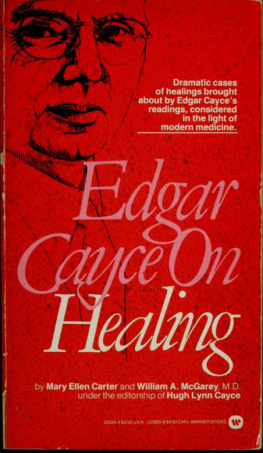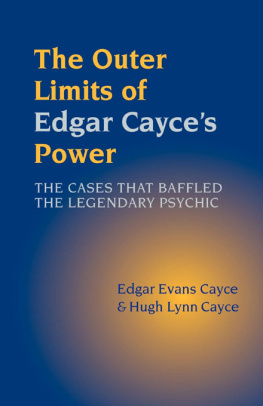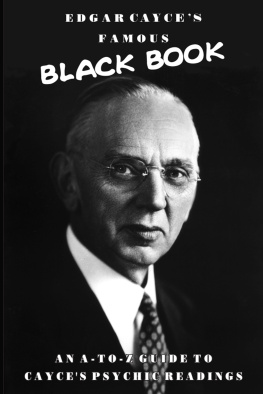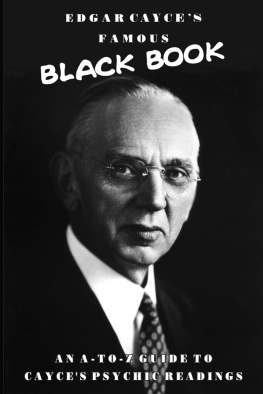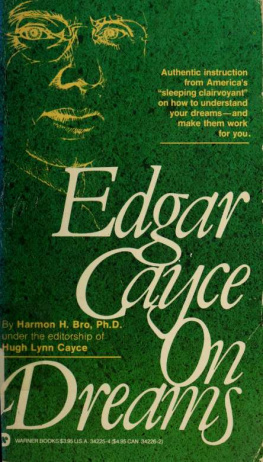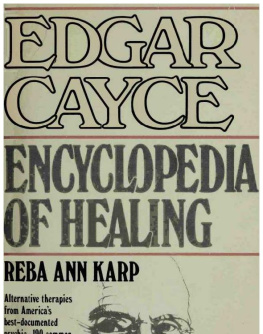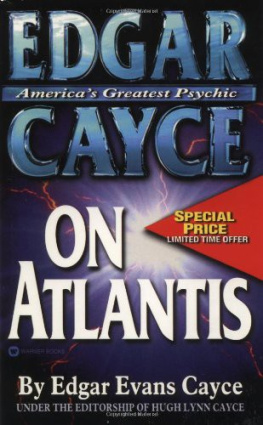EDGAR CAYCE ON HEALING -AN UNUSUAL IN-DEPTH STUDY OF ILLNESSES CURED THROUGH EDGAR CAYCES READINGS
What sort of person turned to Edgar Cayce for medical information? What did it mean to the suffererand to the sufferers familyto receive advice from Americas most famous clairvoyant? What advances has medicine made in the quarter-century since Cayces death that support or illuminate Cayces often unorthodox physical readings?
In the following pages, William A. McGarey, a doctor of medicine, and Mary Ellen Carter, author of Edgar Cayce on Prophecy, provide fascinating answers to these and other questions about the physical readings of Edgar Cayce.
Copyright 1972 by Association for Research and Enlightenment, Inc.
Warner Books, Inc.
666 Fifth Avenue New York, N.Y.
10103
Foreword
The twentieth-century history of parapsychology will probably catalogue Edgar Cayce, one of America's best-documented psychics, as a medical telepathist. The Association for Research and Enlightenment, Inc., a psychical research society, was formed in 1932 to preserve and experiment with his data. Its library in Virginia Beach, Virginia contains 14,246 copies of Edgar Cayce's psychic readings, stenographically recorded over a period of 43 years. Of this number 8,976, or about 64%, describe the physical disabilities of several thousand persons and suggest treatment for their ailments.
For a great many physicians, medical studies of treatment patterns for a number of major physical diseases seem to suggest the advisability of testing Edgar Cayce's theories. With this in mind, the physical readings have been made available to a clinic in Phoenix, Arizona staffed by four medical doctors. Through written reports and yearly conferences, information on results of treatments are being made available to more than 250 M.D.'s and osteopaths.
After two years of clinical work with the readings and ten years of study and testing in private practice, William McGarey, M.D., Director of the A.R.E. Clinic in Phoenix, agreed to collaborate with Mary Ellen Carter, a long time A.R.E. member and widely-known author on Edgar Cayce data, in bringing to print the human interest stories of a selection of original readings given by Edgar Cayce. For each one. Dr. McGarey has added an up-to-date medical commentary. Many of our readers have heard these stories told; here at last are the exciting details.
For some of you, this may be the first introduction to Edgar Cayce. Who was he?
It depends on through whose eyes you look at him. A goodly number of his contemporaries knew the "waking" Edgar Cayce as a gifted professional photographer. Another group (predominantly children) admired him as a warm and friendly Sunday School teacher. His own family knew him as a wonderful husband and father.
The "sleeping" Edgar Cayce was an entirely different figurea psychic known to thousands of people from all walks of life who had cause to be grateful for his help. Indeed, many of them believed that he alone had either saved or changed their lives when all seemed lost. The "sleeping" Edgar Cayce was a medical diagnostician, a prophet, and a devoted proponent of Bible lore.
Even as a child on a farm near Hopkinsville, Kentucky, where he was born on March 18, 1877, Edgar Cayce displayed powers of perception which seemed to extend beyond the normal range of the five senses. At the age of six or seven he told his parents that he was able to see and talk to "visions," sometimes of relatives who had recently died. His parents attributed this to the overactive imagination of a lonely child who had been influenced by the dramatic language of the revival meetings which were popular in that section of the country. Later, by sleeping with his head on his schoolbooks, he developed some form of photographic memory which helped him advance rapidly in the country school. This gift faded, however, and Edgar was only able to complete his seventh grade before he had to go to work.
By the age of twenty-one he had become the salesman for a wholesale stationery company. At this time he developed a gradual paralysis of the throat muscles, which threatened to cause the loss of his voice. When doctors were unable to find a physical cause for this condition, hypnosis was tried but failed to have any permanent effect. As a last resort Edgar asked a friend to help him re-enter the same kind of hypnotic sleep that had enabled him to memorize his schoolbooks as a child. His friend gave him the necessary suggestion, and once he was in a self-induced trance, Edgar came to grips with his own problem. Speaking from an unconscious state, he recommended medication and manipulative therapy which successfully restored his voice and repaired his system.
A group of physicians from Hopkinsville and Bowling Green, Kentucky took advantage of his unique talent to diagnose their own patients. They soon discovered that Cayce needed to be given only the name and address of a patient, wherever he was, to be able to tune in telepathically to that individual's mind and body as easily as if they were both in the same room. He needed no other information regarding any patient
One of the young M.D.'s, Dr. Wesley Ketchum, submitted a report on this unorthodox procedure to a clinical research society in Boston. On October 9, 1910, The New York Times carried two pages of headlines and pictures. From that day on troubled people from all over the country sought help from the "wonder man."
When Edgar Cayce died on January 3, 1945, in Virginia Beach, Virginia, he left the previously mentioned 14,000 documented stenographic records of the telepathic-clairvoyant statements he had given for more than 6000 different people over a period of 43 years. These readings constitute one of the largest and most impressive records of psychic perception ever to emanate from a single individual. Together with their relevant records, correspondence and reports, they have been cross-indexed under thousands of subject headings and placed at the disposal of psychologists, physicians, students, writers and investigators who still come, in increasing numbers, to examine them.

